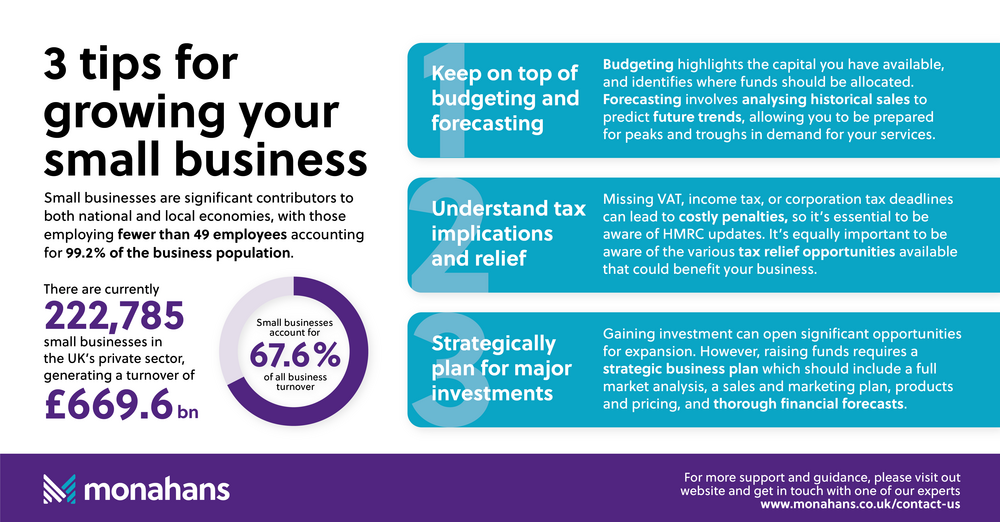7 May 2024
Effective tips for growing a small business

Small businesses are significant contributors to both national and local economies, with those employing fewer than 49 employees accounting for 99.2% of the business population. The successful growth of SMEs relies on the ability to tap into new markets, expand teams, attract investors and introduce new technology.
However, coupled with current economic challenges, cash flow problems and a lack of preparation can present barriers to progression. We look at how, through structured financial planning, businesses can open the doors to expansion.
Keep on top of budgeting and financial forecasting
Budgeting and financial forecasting are the cornerstones of solid growth. Together, they provide a structured roadmap, helping businesses plan for the future, seize opportunities and mitigate risks.
Staying on top of budgeting by regularly monitoring income and expenses helps form a realistic spending plan, track performance and appreciate what financial adjustments should be made. Budgeting highlights the capital available, where funds should be allocated, what future revenue to expect and what fiscal goals should be set. By regularly assessing actual financial performance against budget, businesses can be prepared for otherwise unforeseen expenses that may hinder growth.
In addition, sales forecasting is one of the most important aspects of financial forecasting. By analysing historical sales, predicted future income and market trends, companies gain a clear understanding of what future sales will look like, helping them to reach more informed decisions, spot important financial trends and be prepared for peaks and troughs in demand for their products or services.
Effective planning also involves cash flow forecasting, a tool which predicts the timing of future sales and expenses, highlighting the liquidity of a company and its feasibility for expansion. Plus, by referring to existing and historical revenue data, companies can forecast future revenue – valuable data when seeking investment or forming new relationships with suppliers who will use the information to assess financial robustness.
Understand tax implications and know when you can claim relief
Understanding tax implications and the various tax relief programmes available to your business can contribute to growth plans too. Most small businesses know that missing VAT, income tax, or corporation tax deadlines will lead to costly penalties affecting their bottom line. They may also know that it is important to be aware of rule changes and updates from HMRC to avoid negative financial consequences that can set business expansion plans back.
What is often less known are the various tax relief opportunities available. For instance, the SME R&D tax relief scheme which companies who innovate may be eligible for if, for example, they have made a scientific or technological advancement in a particular field. The scheme lowers the amount of corporation tax paid to reduce the cost of research and development. Similarly, as of 2021, business owners can benefit from tax savings on electric vehicles, a scheme which allows for the full cost of an EV to be offset against annual taxable profits. Some small business can also take advantage of Annual Investment Allowance (AIA), a capital allowance which allows for funds spent on business equipment to be deducted from profits (before tax).
Knowing whether you are eligible and how to apply for tax relief programmes can be complex and may require the support of a professional business advisor or accountant, but if realised, they can offer rewarding benefits for SMEs who want to grow.
Strategically plan for major investments
Gaining investment can open huge opportunities for expansion. However, raising funds takes a separate and concerted effort and a clear and strategic business plan. Primarily, investors will want to see that you have a tangible vision for the business. This should include a breakdown of objectives, who your customers will be, what specific problem is being solved through the business proposal and clear evidence there is a market for your product or service. They will also be keen to see there is firm management in place, how exactly the investment will be used and what the exit strategy is. An effective business plan for investment should define the opportunity available, include a full market analysis, a sales and marketing plan, products and pricing, and thorough financial forecasts.
Understanding the tax relief opportunities available and implementing a structured approach to financial planning can be the lynchpin for small business growth.
For more support and guidance, please get in touch with one of our experts at Monahans.
Fiona Westwood